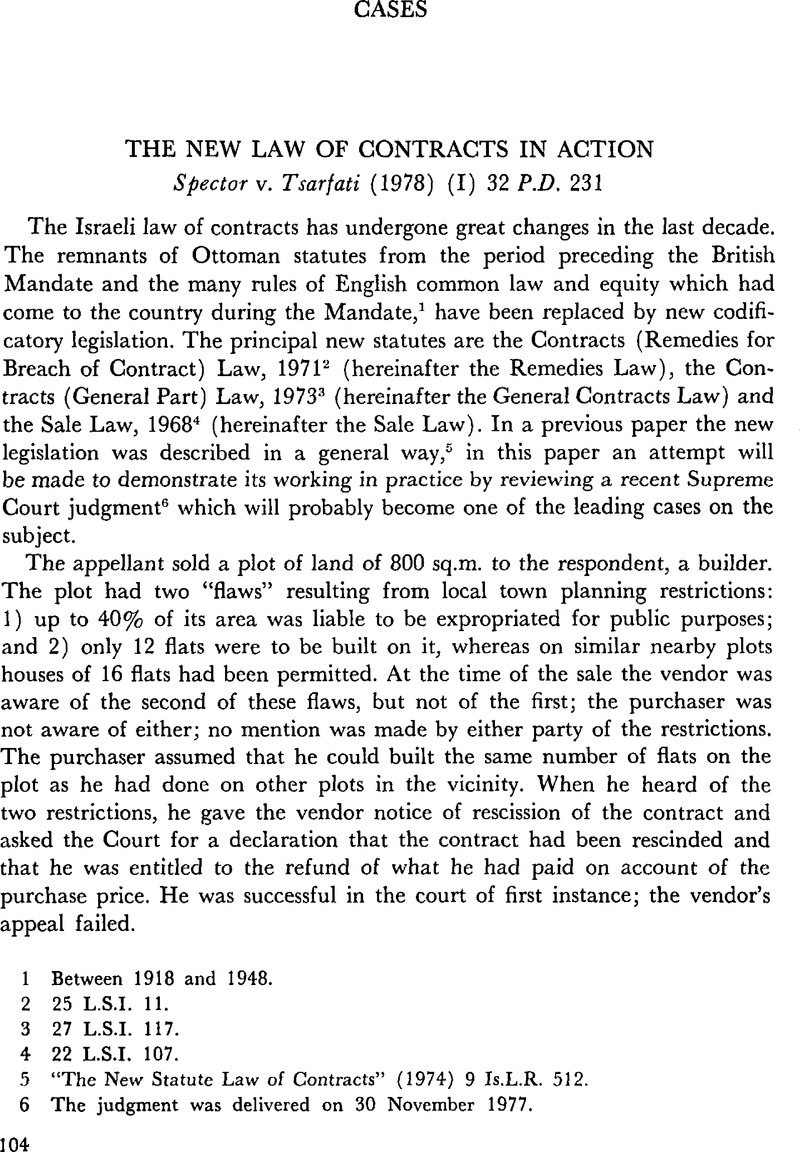Article contents
The New Law of Contracts in Action
Published online by Cambridge University Press: 12 February 2016
Abstract

- Type
- Cases
- Information
- Copyright
- Copyright © Cambridge University Press and The Faculty of Law, The Hebrew University of Jerusalem 1979
References
1 Between 1918 and 1948.
2 25 L.S.I. 11.
3 27 L.S.I. 117.
4 22 L.S.I. 107.
5 “The New Statute Law of Contracts” (1974) 9 Is.L.R. 512.
6 The judgment was delivered on 30 November 1977.
7 The relevant sections are set out hereinafter.
8 Sandbank v. Danziger (1976) (II) 30 P.D. 260.
9 The relevant parts of that section are set out infra under the heading Breach of Contract.
10 (1974) 77 Harv. L.R. 401.
11 The reference is to the General Contracts Law, sec. 12 of which will be dealt with infra.
12 And indeed, sec. 12 is contained in the first chapter of that Law dealing with “The Formation of the Contract” whereas secs. 14, 15 are part of another chapter devoted to “Rescission of the Contract for Defects in its Formation”.
13 A pronouncement more directly on this line comes from Etzioni J. in a case decided on the very same day as the Spector case (Workers' Bank v. Garburg Ltd. (1978) (I) 32 P.D. 253) where he says (at p. 256): “Sec. 15 is to be read together with sec. 12 of the same Law … and undoubtedly the case of fraud is one of the clear cases to which sec. 15 applies”.
14 It should be noted that sec. 61 (b) of the General Contracts Law extends the provisions of that statute, including sec. 39, “also to legal acts other than contracts and to obligations not arising from contract”.
15 The said sec. 6 defines fundamentality of breach in two alternatives ways, one of them corresponding to the fundamentality of mistake envisaged in sec. 14(a) and (b) of the General Contracts Law which have been considered supra.
16 Sec. 7 of the Remedies Law entitles the aggrieved party to rescind the contract also for non-fundamental breach, but in that case reasonable warning has to be given before rescission.
17 Meaning, of course, the stage of negotiations preceding the conclusion of the contract.
18 See supra part 6.
19 Such comparison is of more than academic interest because according to the new statutes the previous law continues to apply to contracts concluded prior to their commencement.
20 Smith v. Hughes (1871) L.R. 6 Q.B. 597.
21 Beit Hashmonaim Ltd. v. Aharoni (1976) (II) 30 P.D. 141.
22 In the mitigated form followed in England since 1966 and in Israel since the Courts Law, 1957.
23 Cf. Yadin, U., “To What Extent are Judicial Decisions and Legal Writings Sources of Law?” (1974) The Ninth Congress of Comparative Law 33.Google Scholar
24 This point will be developed in the next section.
25 For a recent survey of these cases see Yadin, , “On the Interpretation of Statutes of the Knesset, for the Fourth Time” (1978) 31 HaPraklit 395.Google Scholar
26 For both sec. 11 and sec. 18 of the Sale Law see supra part 6.
27 Marko v. Rotfeld (1976) (II) 30 P.D. 393.
28 Accordingly even the purchaser's gross negligence which Landau J. had found with regard to sec. 15 of the General Contracts Law was not sufficient to defeat his reliance on non-conformity (p. 247).
29 It will be remembered that he was dealing with sec. 12 of the General Contracts Law.
30 Op. cit. supra n. 25.
31 After the completion of this note, an English decision in a case with surprisingly similar facts was reported: Lawrence v. Lexcourt Holdings Ltd. [1978] 2 All E.R. 810.
- 1
- Cited by




